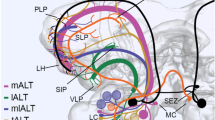Summary
-
1.
Impulses were picked up extracellularly from single neurons in a defined region of the deutocerebrum when antennal receptors were adequately stimulated.
-
2.
Each neuron responded to several stimulus modalities: odor, mechanical stimulation, temperature change (Table 1). The responses of receptors in various sections of the ipsilateral antenna converged on single neurons as well.
-
3.
The response in a given multimodal neuron consists of on, off, and on-off reactions. These responses to odors are determined less by the kind of odor than by its intensity (Fig. 2, Table 2).
-
4.
No two multimodal neurons were completely alike in their reactions. Their odor spectrum is much broader than that of any antennal receptors and central neurons investigated thus far. They responded to: cinnamic aldehyde, aliphatic amines, fatty acids and alcohols, homogenized fruits, and putrid meat (Tables 1, 2).
-
5.
The response of all multimodal neurons to mechanical and thermal stimulation was uniform, in contrast to their response to odors (Table 1).
-
6.
Topographical and functional differences from unimodal neurons found in the same region of the brain are noted (Table 3).
Zusammenfassung
-
1.
Die Impulse einzelner Neurone wurden extrazellulär bei adäquater Reizung antennaler Sinnesorgane aus einer bestimmten Region des Deutocerebrum registriert.
-
2.
Jedes Neuron antwortet auf mehrere Beizmodalitäten: Geruch, mechanische Reize und Temperaturänderung (Tabelle 1). Außerdem konvergiert auf ein Neuron die Erregung von Rezeptoren verschiedener Abschnitte der ipsilateralen Antenne.
-
3.
Die Antwort eines solchen multimodalen Neurons besteht in on-, off- und on/off-Reaktionen. Bei Duftreizen hängt es nicht nur von der Qualität, sondern vor allem von der Intensität ab, welche dieser Reaktionsweisen auftritt (Abb. 2, Tabelle 2).
-
4.
Alle multimodalen Neurone unterscheiden sich durch ihre Reaktion voneinander. Ihr Duftspektrum ist wesentlich breiter als das der bisher untersuchten Rezeptoren und zentralen Neurone: Zimtaldehyd, aliphatische Amine, Fettsäuren und Alkohole, Homogenisate von Früchten und faulem Fleisch werden beantwortet (Tabellen 1, 2).
-
5.
Im Unterschied zu den Duftreizen werden mechanische und Temperaturreize von allen multimodalen Neuronen sehr einheitlich beantwortet (Tabelle 1).
-
6.
Es werden topographische und funktionelle Unterschiede zu den bekannten unimodalen Neuronen in derselben Gehirnregion angegeben (Tabelle 3).
Similar content being viewed by others
Literatur
Altner, H., Ernst, K. D., Kolnberger, I., Loftus, R.: Feinstruktur und adäquater Reiz bei Insektensillen mit Wandporen. Verh. dtsch. zool. Ges. Mainz66, 48–53 (1972)
Bernard, J., Pinet, J. M., Boistel, J.: Électrophysiologie des recepteurs des stylets maxillaires deTriatoma infestans—Action de la température et de la teneur en eau de l'air. J. Insect Physiol.16, 2157–2180 (1970)
Boeckh, J.: Die Reaktionen von Neuronen im Deutocerebrum der Wanderheuschrecke bei Duftreizung der Antennen. Verh. dtsch. zool. Ges. Mainz66, 189–193 (1972)
Boeckh, J.: Die Reaktionen olfaktorischer Neurone im Deutocerebrum von Insekten im Vergleich zu den Antwortmustern der Geruchssinneszellen. J. comp. Physiol.90, 183–205 (1974)
Boeckh, J., Ernst, K. D., Sass, H., Waldow, U.: Coding of odor quality in the insect olfactory pathway. V. Int. Symp. Olfaction and Taste. ed. D. Denton Melbourne: In print 1975
Boeckh, J., Sandri, C., Akert, K.: Sensorische Eingänge und synaptische Verbindungen im Zentralnervensystem von Insekten. Z. Zellforsch.103, 429–446 (1970)
Hanström, B.: Vergleichende Anatomie des Nervensystems der wirbellosen Tiere unter Berücksichtigung seiner Funktion. Berlin: Springer (1928); Nachdruck. Amsterdam: A. Ashe & Co. 1968
Jawlowski, H.: Studies on the insects brain. Ann. Univ. Maria Curie-Skłodowska, Lublin3C, 1–37 (1948)
Kafka, W. A.: Molekulare Wechselwirkungen bei der Erregung einzelner Riechzellen. Z. vergl. Physiol.70, 105–143 (1970)
Kaissling, K.-E.: Insect olfaction. In: Handbook of sensory physiology. Vol. IV: Chemical senses, part 1: Olfaction (L. M. Beidler, ed.), p. 351–431. Berlin-Heidelberg-New York: Springer 1971
Lambin, M.: Les sensilles de l'antenne chez quelques blattes et en particulier chezBlaberus craniifer (Burm.) Z. Zellforsch.143, 183–206 (1973)
Loftus, R.: The response of the antennal cold receptor ofPeriplaneta americana to rapid temperature changes and to steady temperature. Z. vergl. Physiol.59, 413–455 (1968)
Loftus, R.: Differential thermal components in the response of the antennal cold receptor ofPeriplaneta americana to slowly changing temperature. Z. vergl. physiol.63, 415–433 (1969)
Mimura, K., Tateda, H., Morita, H., Kuwabara, M.: Regulation of insect brain excitability by ocellus. Z. vergl. Physiol.62, 382–394 (1969)
Sass, H.: Das Zusammenspiel mehrerer Rezeptortypen bei der nervösen Codierung von Geruchsqualitäten. Verh. dtsch. zool. Ges. Mainz66, 198–201 (1972)
Sass, H.: Die Erregungsmuster antennaler Geruchsrezeptoren vonPeriplaneta americana bei Reizung mit Futterdüften und deren Inhaltsstoffen. Diss. nat.-wiss. Fakultät Regensburg 1974
Schafer, R., Sanchez, T. V.: Antennal sensory system of the cockroach,Periplaneta americana: postembryonic development and morphology of the sense organs. J. comp. Neurol.149, 335–354 (1973)
Suzuki, H., Tateda, H.: An electrophysiological study of olfactory interneurons in the brain of the honey-bee. J. Insect Physiol.20, 2287–2299 (1974)
Thurm, U.: Die Beziehung zwischen mechanischen Reizgrößen und stationären Erregungszuständen bei Borstenfeld-Sensillen von Bienen. Z. vergl. Physiol.46, 351–382 (1963)
Weiss, M. J.: Neuronal connections and the function of the Corpora pedunculata in the brain of the American cockroach,Periplaneta americana (L.). J. Morph.142, 21–70 (1974)
Yamada, M.: Extracellular recording from single neurons in the olfactory centre of the cockroach. Nature (Lond.)217, 778–779 (1968)
Yamada, M.: A search for odour encoding in the olfactory lobe. J. Physiol. (Lond.)214, 127–143 (1971)
Author information
Authors and Affiliations
Rights and permissions
About this article
Cite this article
Waldow, U. Multimodale Neurone im Deutocerebrum vonPeriplaneta americana . J. Comp. Physiol. 101, 329–341 (1975). https://doi.org/10.1007/BF00657049
Received:
Issue Date:
DOI: https://doi.org/10.1007/BF00657049




